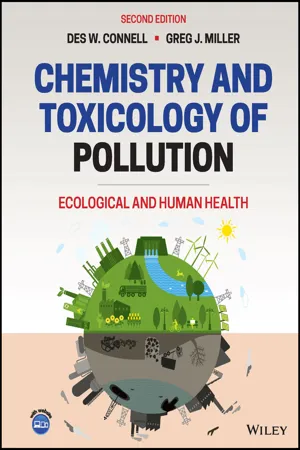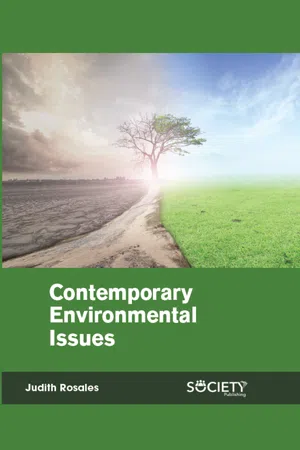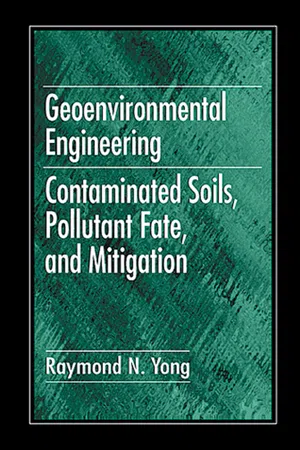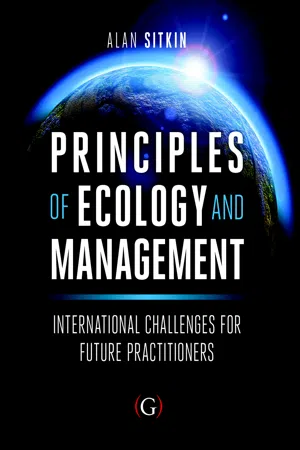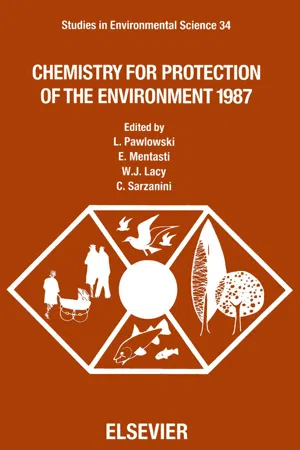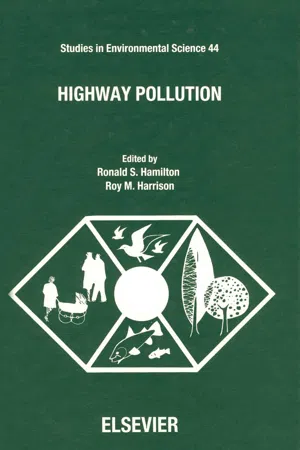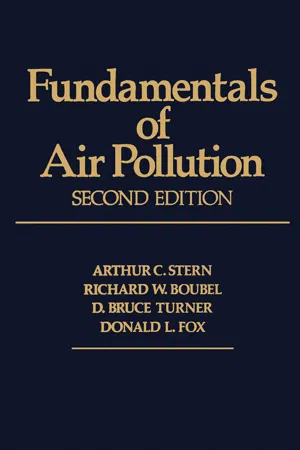Geography
Pollutants
Pollutants are substances or energy forms that, when introduced into the environment, can cause harm or discomfort to living organisms or disrupt the natural balance of ecosystems. They can be in the form of chemicals, particulates, or biological materials and are often the result of human activities such as industrial processes, transportation, and agriculture.
Written by Perlego with AI-assistance
Related key terms
1 of 5
10 Key excerpts on "Pollutants"
- eBook - PDF
Chemistry and Toxicology of Pollution
Ecological and Human Health
- Des W. Connell, Gregory J. Miller(Authors)
- 2022(Publication Date)
- Wiley(Publisher)
It may be described as a waste material, sub- stance, or energy form that pollutes the environment, or more specifically, air, water, soil, plants, animals, and humans. Pollutants can take the form of artificial substances such as synthetic pesticides and industrial chemicals (e.g. PFAS) or natural substances such as heavy metals, carbon dioxide, petroleum hydrocarbons, and ionizing radiation. The definition of a pollutant may vary in scope from contamination of the environment, such as air or water, to adverse effects or damage to living organisms, including humans, components of the environments, environmental values, and use. As such, the effects of a pollutant are usually defined by the presence of harmful concentrations above normal, background, or measured no effect levels. Importantly, the nature, behavior, fate, and effects of a pollutant are influenced by its physical, chemical, and biological properties. There are many different definitions of Pollutants depending upon the context of pollution, such as a water or air pollutant, and popular, scientific, legal, or regula- tory use of the term. Examples of a broad definition of a pollutant are given below: Something that pollutes, especially a waste material that contaminates air, soil, or water – The American Heritage ® Dictionary of the English Language (2020). Based on a definition proposed by the European Environ- ment Agency, The Lancet Commission on Pollution and Health defined pollution as Any material introduced into the environment by human activity that endangers human health or harms living resources and ecosystem (Fuller et al. 2018). Chemistry and Toxicology of Pollution: Ecological and Human Health, Second Edition. Des W. Connell and Greg J. Miller. © 2023 John Wiley & Sons, Inc. Published 2023 by John Wiley & Sons, Inc. Companion website: www.wiley.com/go/toxicologyofpollution2e - eBook - PDF
- Judith Rosales(Author)
- 2019(Publication Date)
- Society Publishing(Publisher)
Pollution is defined as the introduction of harmful substances or products into the environment, which is typically foreign substances, particularly a contaminant or toxin that produces some kind of a negative or harmful impact on the environment or living beings. Pollution presents in many forms ranging from chemicals in the form of gases or liquids, noise, energy sources such as light or heat, or solids such as the types of waste that end up in landfills. Even naturally occurring substances, such as carbon dioxide and mercury, can be considered polluted when additional quantities are added to the environment in unsafe proportions by industries which can have detrimental effects on the environment and all forms of lives (Figure 2.1). One of the greatest problems that the world is facing today is that of environmental pollution, which is causing grave and irreparable damage to the natural world and human society with about 40% of deaths worldwide being caused by water, air, and soil pollution and coupled with human overpopulation has contributed to the malnutrition of 3.7 billion people worldwide, making them more vulnerable to diseases. Contemporary Environmental Issues 28 Figure 2.1: Illustrating the contribution towards environmental pollution. Source: https://cdn.pixabay.com/photo/2017/06/04/04/16/warm-ing-2370285_960_720.jpg Pollution happens when the natural environment cannot destroy an element without creating harm or damage to itself. The elements involved are not produced by nature, and the destroying process can vary from a few days to thousands of years. In other words, pollution takes place when nature does not know how to decompose an element that has been brought to it in an unnatural way, such as the use of plastics. Every day the Government trying to restrict the use of plastics and plastic bags and taking many initiatives by imposing fines also to reduce its use, since it is harmful to the environment and cannot be decomposed naturally. - eBook - PDF
Geoenvironmental Engineering
Contaminated Soils, Pollutant Fate, and Mitigation
- Raymond N. Yong(Author)
- 2000(Publication Date)
- CRC Press(Publisher)
Whilst it is tempting to consider Pollutants as contaminants originating from anthropogenic activities, this simplistic distinction may not serve us well inasmuch as natural Pollutants can also be severe health threats. The fundamental premise that governs pollution mitigation (i.e., removal or reduction of pollutant concentration) and remediation of contaminated lands should be protection of health of biotic species and land environment. Accord-ingly, as in Chapter 1, we will use the term pollutant to emphasize the contamination problem under consideration, and also when we mean to address known health-hazard 102 GEOENVIRONMENTAL ENGINEERING contaminants (specifically or in general). We will continue to use the term contami-nant when we deal with general theories of contaminant-soil interactions. The description of the ultimate or long-term nature and distribution of Pollutants introduced into the substrate is generally described as the fate of Pollutants. The fate of Pollutants depends on the various interaction mechanisms established between Pollutants and soil fractions, and also between Pollutants and other dissolved solutes present in the porewater. The general interactions and processes contributing to the fate of contaminants and Pollutants is shown in Figure 4.1. We will consider these in greater detail in the next few chapters. At this stage we can consider the four main groups of events that fall under a general characterization described in overall terms as fate description : 1. Persistence — this includes pollutant recalcitrance, degradative and/or intermedi-ate products, and partitioning; 2. Accumulation — describes the processes involved in the removal of the contaminant solutes from solution, e.g., adsorption, retention, precipitation, and complexation; 3. Transport — accounts for the environmental mobility of the contaminants and includes partitioning, distribution, and speciation; 4. - eBook - PDF
Air Pollution V1
Air Pollutants, Their Transformation and Transport
- Arthur C. Stern(Author)
- 2015(Publication Date)
- Academic Press(Publisher)
Perhaps it may within a few generations compete with radioactive wastes for the dubious distinction of being a worldwide air polluter. Any substantial shift of energy dependence from fossil fuels to nuclear or solar power plants will tend to reestablish the planetary C 0 2 equilib-rium. It is especially exciting to consider the air conservation potential of solar energy and other nonpolluting power sources now being explored. Should these prove capable of displacing current combustive transforma-tions, the community air pollution problem would be reduced to more or less routine policing of localized sources. III. Primary Concepts of Air Pollution A variety of definitions of air pollution have been devised, each ex-pressing more or less completely the individual philosophical, theoretical, practical, or protective motivation of its author. Any circumstance which adds to or subtracts from the usual constituents of air may alter its physi-cal or chemical properties sufficiently to be detected by occupants of the medium. It is usual to consider as Pollutants only those substances added in sufficient concentration to produce a measurable effect on man or other animals, vegetation, or material. Pollutants may therefore include almost any natural or artificial com-position of matter capable of being airborne. They may occur as solid particles, liquid droplets, gases, or in various admixtures of these forms. 14 LESLIE A. CHAMBERS Pollution of the air by a single chemical species appears to be a most unusual event; certainly most community problems involve a very large number of kinds and sizes of substances. In an effort to classify the Pollutants thus far recognized, it is conve-nient to consider two general groups: (a) those emitted directly from identifiable sources, and (b) those produced in the air by interaction among two or more primary Pollutants, or by reaction with normal atmo-spheric constituents, with or without photoactivation. - eBook - PDF
- Alan Sitkin(Author)
- 2011(Publication Date)
- Goodfellow Publishers(Publisher)
Pollution is a very general word encompassing a variety of situations. Toxicity studies Scientists have several ways of apprehending the pollution caused by companies and its effects. Usually, the main focus will involve examining the damage caused when Pollutants interact with their sur-roundings, i.e. the level of toxicity. In turn, this will depend on a host of factors, first and foremost being the possibility of ‘dilution’, or the principle that the lower the concentration of a pollutant in proportion to the agents (water, solvents) capable of dissipating its effects, the greater the chance of containing any negative side effects. Thus, an ele-ment that is non-toxic in small doses will often become toxic in larger quantities. Of course, the notion of concentration must be understand not only in volume and quantity terms but even more importantly in terms of the pollutant’s capacity for causing harm, and to what extent it might be broken down into something less noxious. Clearly, radio-Pathogen: Biological agent causing disease in living organisms. Principles of Ecology and Management 56 active waste from a hospital or nuclear power station causes greater harm and dilutes less effectively (or indeed, not at all) than de-greased sludge taken from factory machines. Note that this latter instance raises a second issue, namely whether the product used to eliminate an unwanted substance should also be classified as a pollutant, as is often the case when companies use chemical additives for their cleaning properties. Problems of this nature have sparked enormous interest in the field of green chemistry . Other kinds of analysis will focus on how Pollutants disperse from their point(s) of origin. Liquids, solids and gases spread throughout the environment at varying speeds. In turn, this affects surrounding ecosystems’ ability to withstand their presence. - eBook - PDF
- Dhankhar, Rajesh(Authors)
- 2021(Publication Date)
- Daya Publishing House(Publisher)
A Environmental Pollution Definition Types of Pollution Disaster Management Definition ny change in the physical, chemical and biological characteristics of air, water and soil that affect the health or activities of human beings or other forms of life in an undesirable manner is the result of pollution. Pollution not only causes physical harm but also psychological distress, foul odours, unpleasant sights, noise, heat etc. In other words, pollution is a direct or indirect change in any component of the biosphere that is harmful to the living components. This ebook is exclusively for this university only. Cannot be resold/distributed. Pollution is caused by Pollutants. Some of the main Pollutants are gases, metals, deposited matter, poison, sewage water, fertilisers, radioactive substances, heat and noise. These Pollutants are of two types–biodegradable Pollutants and non-biodegradable Pollutants. The substances that decompose slowly in the natural environment are known as non biodegradable whereas those substances that can decompose naturally in the environment are known as biodegradable, such as sewage waste. The sewage wastes are rapidly decomposed by natural processes. Non biodegradable substances accumulate along the food chain and became biologically magnified. Types of Pollution Pollution is of two types: Natural pollution: Pollution that originates from natural processes. Artificial pollution: Pollution that originates from the activities of man. Air Pollution When the concentration of normal component of air or some chemical added, or formed in the air upto the point of causing harm to the living organisms or to materials. The addition of chemical to air leads to pollution of air is called pollution or atmospheric pollution. Air pollution is one of the most dangerous pollution and reported mainly in the metropolitans and industrial area. The first case of air pollution was found in Belgium 1990. - eBook - PDF
Fundamentals of Environmental and Toxicological Chemistry
Sustainable Science, Fourth Edition
- Stanley E. Manahan(Author)
- 2013(Publication Date)
- CRC Press(Publisher)
181 7 Pollution of the Atmosphere 7.1 POLLUTION OF THE ATMOSPHERE AND AIR QUALITY In Chapter 6, the atmosphere was introduced as one of the five main parts of the environment. In this chapter, pollution of the atmosphere is discussed. Atmospheric quality is extremely important for human welfare, in part because of the intimate relationship that we have with air in the atmo-sphere. It is almost impossible in a practical sense to avoid breathing air as we find it around us. Toxic air Pollutants will get into our lungs. In the innermost alveoli of the lungs where gases are interchanged between air that is inhaled and blood in the bloodstream, a layer only the thickness of a single human cell separates the blood from the air. If the air that we breathe is polluted, we may be harmed by it. In addition to human health effects, there are other reasons to be concerned about air pollution. Plants may be harmed by air Pollutants. Acids in the atmosphere may attack materials and cause corrosion to occur. And the most damaging air Pollutants of all may turn out to be the greenhouse gases, especially carbon dioxide and methane, that get into the atmosphere in part from natural sources, but which in excess from anthrospheric sources are causing global warming and may result in massive alteration of Earth’s climate. Global climate change is discussed in Chapter 8, which deals with sustaining the atmosphere. In discussing atmospheric pollution, it is important to make the distinction between primary and secondary air Pollutants. Primary air Pollutants are those that are Pollutants in the form in which they are emitted into the atmosphere. An example would be light-scattering fine ash par-ticles ejected from a smokestack. Secondary air Pollutants are those that are formed from other substances by processes in the atmosphere. - L. Pawlowski, E. Mentasti, W.J. Lacy, C. Sarzanini(Authors)
- 1988(Publication Date)
- Elsevier Science(Publisher)
Another factor is the localization of the monitoring stations which depends on an accurate analysis of the industrial and urban sites and of the distinctive nature of the territory. The ecological “history” of the site should also direct the choice of the sanipling position. The territorial characteristics of the Pienionte Region present a wide variety of situations which may help to discuss the above mentioned points. 18 The problem of atmospherical and soil pollution cannot be considered as something new for it has accompanied mankind in all aspects of his life. The fact that pollution is perceived depends on an awareness of its existence. Our awareness is due to technological progress which both creates more pollution and provides US with the means to reveal it and consequently prevent it. One of our past and present difficulties is that the growth of pollution due to human activities and then its identification do not occur at the same time. Today, certainly, we have more reliable ideas about what the polluting factors might be and they must be checked out even if the real toxic nature of a substance cannot always be fully determined. However, we are able to work out tables that give us a fair idea of what to look for and enable us to classify the Pollutants. We can then construct suitable parameters for identification and to give us a chance to control the most important sources of industrial and urban pollution. Legislation covers different types of waste from liquid and solid waste to emission of gas. In the case of industrial waste, special attention has recently been paid to solid waste, the elimantion of which can seriously affect the quality of water and of the atmosphere through the spreading of Pollutants coming from the disposal processes. A territory like that surrounding the city of Turin, with its industrial vocation, offers a wide field of study for the resulting Pollutants.- eBook - PDF
- R.S. Hamilton, R.M. Harrison(Authors)
- 1991(Publication Date)
- Elsevier Science(Publisher)
More recently, vehicle emissions have been implicated in a range of health effects (see Chapter 7) and also in acid deposition, photochemical smog, global climatic change and the soiling of surfaces. The deposition of these vehicle-emitted Pollutants has implications for ecosystems; this is reviewed in Chapter 8. Similarly, highway runoff has only recently been recognised as an important constituent of urban, non-point source pollution. Some studies have suggested that even though highways may only occupy 5 4 % of the urban catchment area, highway drainage can contribute as much as 50% of the total suspended solids, 16% of the total hydrocarbons and 75% of the total metal inputs to a receiving stream [2]. These loadings are a result of both the pollutant input to the highway surface and modifications to local hydrology imposed by the design and construction of the highway (Chapters 4 and 5). Finally, noise from road traffic has been identified as a nuisance to a large proportion of the population (Chapter 9). From this brief review, it is clear that highway sources are involved in pollution of the atmosphere, surface dust, soil and water (including rainfall and runoff). Material and acoustic forms of pollution are involved, both may exert adverse effects on the living and non-living environment and these effects are expected to increase in the years ahead. The aim of this book is to examine and quantify these pollutant sources, their transport through the environment, the monitoring of their levels, and their effects. Finally, the potential for technological and legal control is considered. 1.2 Sources, Transwrt and Levels The levels of Pollutants at any point in the environment are determined by: i) source emission rates, ii) dispersion characteristics, iii) removal rates. Emissions to the atmosphere near highways are mainly from the vehicle exhaust. This source is responsible for virtually all of the carbon monoxide, nitrogen oxides and lead compounds emitted. - eBook - PDF
- Arthur C. Stern(Author)
- 1984(Publication Date)
- Academic Press(Publisher)
Fig. 6-1. Mt. St. Helens during the eruption of May 1980. Source: Photo by C. Rosenfeld, Oregon Air National Guard. 78 6. Sources of Air Pollution Fig. 6-2. Uncontrolled forest fire. Source: Information and Education Section, Oregon Department of Forestry. Dust storms that entrain large amounts of particulate matter are a com-mon natural source of air pollution in many parts of the world. Even a relatively small dust storm can result in suspended particulate matter read-ings one or two orders of magnitude above ambient air quality standards. Visibility reduction during major dust storms is frequently the cause of severe highway accidents and can even affect air travel. The particulate matter transferred by dust storms from the desert to urban areas causes problems to householders, industry, and automobiles. The materials re-moved by the air cleaner of an automobile are primarily natural Pollutants such as road dust and similar entrained material. The oceans of the world are an important natural source of pollutant material. The ocean is continually emitting aerosols to the atmosphere, in the form of salt particles, which are corrosive to metals and paints. The action of the waves on the rocks reduces them to sand which may eventually become airborne. Even the shells washed up on the beach are eroded by wave and tidal action until they are reduced to such a small size that they too may become airborne. An extensive source of natural Pollutants is the plants and trees of the earth. Even though these green plants play a large part in the conversion of I. General 79 carbon dioxide to oxygen through photosynthesis, they are still the major source of hydrocarbons on the planet. The familiar blue haze over forested areas is nearly all from the atmospheric reactions of the volatile organics given off by the trees of the forest (1).
Index pages curate the most relevant extracts from our library of academic textbooks. They’ve been created using an in-house natural language model (NLM), each adding context and meaning to key research topics.
